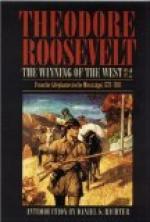These various ravages and skirmishes were but the prelude to a far more serious attack. In July the British captains Caldwell and McKee came down from Detroit with a party of rangers, and gathered together a great army of over a thousand Indians [Footnote: Haldimand MSS. Letter from Capt. Caldwell, August 26, 1782; and letter of Captain McKee, August 28, 1782. These two letters are very important, as they give for the first time the British and Indian accounts of the battle of the Blue Licks; I print them in the Appendix.]—the largest body of either red men or white that was ever mustered west of the Alleghanies during the Revolution. They meant to strike at Wheeling; but while on their march thither were suddenly alarmed by the rumor that Clark intended to attack the Shawnee towns. [Footnote: This rumor was caused by Clark’s gunboat, which, as will be hereafter mentioned, had been sent up to the mouth of the Licking; some Shawnees saw it, and thought Clark was preparing for an inroad.] They at once countermarched, but on reaching the threatened towns found that the alarm had been groundless. Most of the savages, with characteristic fickleness of temper, then declined to go farther; but a body of somewhat over three hundred Hurons and Lake Indians remained. With these, and their Detroit rangers, Caldwell and McKee crossed the Ohio and marched into Kentucky, to attack the small forts of Fayette County.
Fayette lay between the Kentucky and the Ohio rivers, and was then the least populous and most exposed of the three counties into which the growing young commonwealth was divided. In 1782 it contained but five of the small stockaded towns in which all the early settlers were obliged to gather. The best defended and most central was Lexington, round which were grouped the other four—Bryan’s (which was the largest), McGee’s, McConnell’s, and Boon’s. Boon’s Station, sometimes called Boon’s new station, where the tranquil, resolute old pioneer at that time dwelt, must not be confounded with his former fort of Boonsborough, from which it was several miles distant, north of the Kentucky. Since the destruction of Martin’s and Ruddle’s stations on the Licking, Bryan’s on the south bank of the Elkhorn was left as the northernmost outpost of the settlers. Its stout, loopholed palisades enclosed some forty cabins, there were strong block-houses at the corners, and it was garrisoned by fifty good riflemen.
These five stations were held by backwoodsmen of the usual Kentucky stamp, from the up-country of Pennsylvania, Virginia, and North Carolina. Generations of frontier life had made them with their fellows the most distinctive and typical Americans on the continent, utterly different from their old-world kinsfolk. Yet they still showed strong traces of the covenanting spirit, which they drew from the Irish-Presbyterian, the master strain in their mixed blood. For years they had not seen the inside of a church; nevertheless, mingled with men who were loose of tongue and life, there still remained many Sabbath-keepers and Bible-readers, who studied their catechisms on Sundays, and disliked almost equally profane language and debauchery. [Footnote: McAfee MSS.]




